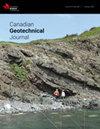Structural evolutions of MX80 bentonite pellet/powder mixtures under wetting and suction-controlled oedometer loading
IF 3.5
3区 工程技术
Q2 ENGINEERING, GEOLOGICAL
引用次数: 0
Abstract
Canadian Geotechnical Journal, Ahead of Print.The compression behaviour of MX80 bentonite pellet/powder mixture was investigated by performing suction-controlled oedometer tests. The suction from 113 to 4.2 MPa was imposed by vapour equilibrium technique (VET), and zero suction by water circulation (WC). After instantaneously unloaded from various target vertical stresses, the structural observation was conducted by mercury intrusion porosimetry and micro-computed tomography. Results showed that during wetting, the intra-grain micro- and macro-pores increased due to the swelling of pellets and powder grains. During loading, the variation of intra-grain micro-pores was characterised by the loading effect, while that of intra-grain micro-pores was controlled by the suction and loading effects. The inter-grain pores, for the VET samples, were reduced by the swelling of pellets and powder grains during wetting on one hand, and by the movement of pellets and powder grains during loading on the other hand. For the WC samples, most inter-grain pores were closed during wetting, with a few pores in the top closed by further loading. The global compression of bentonite mixture samples during loading was mainly governed by the filling of inter-grain pores for the VET samples, but controlled by the compression of intra-grain pores for the WC samples.
MX80膨润土颗粒/粉末混合物在湿润和吸力控制的比重计加载条件下的结构演变
加拿大岩土工程学报》,提前出版。 通过进行吸力控制的气压计试验,研究了 MX80 膨润土颗粒/粉末混合物的压缩行为。通过蒸汽平衡技术(VET)施加 113 至 4.2 兆帕的吸力,通过水循环(WC)施加零吸力。在瞬时卸载各种目标垂直应力后,采用汞侵入孔隙模拟法和微型计算机断层扫描法进行结构观察。结果表明,在润湿过程中,由于颗粒和粉末颗粒的膨胀,颗粒内的微孔和大孔增加。在加载过程中,粒内微孔的变化受加载效应的影响,而粒内微孔的变化则受吸力和加载效应的控制。对于 VET 样品,一方面由于润湿过程中颗粒和粉末颗粒的膨胀,另一方面由于加载过程中颗粒和粉末颗粒的移动,晶粒间的孔隙减少了。至于 WC 样品,大部分晶粒间的孔隙在润湿过程中被封闭,顶部的少数孔隙在进一步加载后被封闭。对于 VET 样品,装载过程中膨润土混合物样品的整体压缩主要受晶粒间孔隙填充的影响,而对于 WC 样品,则受晶粒内孔隙压缩的影响。
本文章由计算机程序翻译,如有差异,请以英文原文为准。
求助全文
约1分钟内获得全文
求助全文
来源期刊

Canadian Geotechnical Journal
地学-地球科学综合
CiteScore
7.20
自引率
5.60%
发文量
163
审稿时长
7.5 months
期刊介绍:
The Canadian Geotechnical Journal features articles, notes, reviews, and discussions related to new developments in geotechnical and geoenvironmental engineering, and applied sciences. The topics of papers written by researchers and engineers/scientists active in industry include soil and rock mechanics, material properties and fundamental behaviour, site characterization, foundations, excavations, tunnels, dams and embankments, slopes, landslides, geological and rock engineering, ground improvement, hydrogeology and contaminant hydrogeology, geochemistry, waste management, geosynthetics, offshore engineering, ice, frozen ground and northern engineering, risk and reliability applications, and physical and numerical modelling.
Contributions that have practical relevance are preferred, including case records. Purely theoretical contributions are not generally published unless they are on a topic of special interest (like unsaturated soil mechanics or cold regions geotechnics) or they have direct practical value.
 求助内容:
求助内容: 应助结果提醒方式:
应助结果提醒方式:


